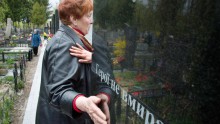The Ukrainian Helsinki Human Rights Union, with the support of the Ministry of Foreign Affairs of the Czech Republic and within the framework of the Transition Promotion Program project, will soon present in Dnipro information resource The Memory Map which lists the victims of the armed conflict in eastern Ukraine. Before the presentation of the project, The Day’s reporter spoke to its participants, who demonstrated firsthand how the resource works.
The Memory Map is an actual interactive map which has its points marked in chronological order with the names of those identified as those who have perished as a result of the Russian-Ukrainian War. The dead are classified both by the date of death and by the country of origin, which is very significant. One can clearly see that all of Ukraine has shed blood to stop the occupiers’ advance. At the same time, the “rash” created on the map by Russian cities where militants came from demonstrates how Russian citizens joined the war in eastern Ukraine. That is, it becomes clear how the whole of Ukraine answered the call to defend our soil and how many mercenaries and regular army soldiers of the Russian Federation have fought against the Ukrainians. The break-up of victims into combatants and non-combatants deserves a special mention. The Russian side has been well-known to attempt to disguise its presence in the territory of Ukraine in every possible way. Speaking of deaths, they do it by reporting dead soldiers as civilians. This greatly complicates the information collection effort in the occupied territories. According to the project’s participants, the fragmentation and contradictions in databases complicate shaping the national information policy and launching effective counteraction to false information and manipulations. This, in turn, threatens the rights of citizens to access information, welfare services and legal aid.
The project’s principal aim is not only to collect the most reliable information about the deaths in the Donbas, but also to provide the general public and relevant agencies with adequate and objective data after the war ends. However, in working on the project, the team has faced a number of natural problems as well as bureaucratic obstacles.
“There is a tendency in this country to focus on the fight against corruption and the urgency of reforms, while the study of real losses in the war has been relegated to the second place,” said Valerii Sniehyriov, an analyst at the Ukrainian Helsinki Human Rights Union’s Documentation Center. “In fact, this issue is too ideologized by both sides of the conflict. One side say that since the signing of the Minsk II Agreements, there have been almost no casualties on our part, while their opponents talk about the bloody shelling of civilians or ‘little crucified boys.’ But, unfortunately, the database of the dead still has not been created. We still have people missing. These exist in a limbo, which allows the state to save on appropriate payments to their families. After creating a single database of the dead, we will be able to ask questions about this category. In addition, not all the dead have been identified, located, and had the circumstances of their deaths established. To all these questions, the Memory Map must eventually provide answers. Eventually the database of the dead should become the subject of a discussion after the end of the war. Statistics avoids political speculation and gives us an opportunity to see the picture objectively. The relevant argumentation is thus strengthened.”
“Unfortunately, in the ‘best’ Soviet traditions, we still witness departmental approach everywhere, as the Ministry of Defense counts its own losses, while the Border Guards, the Security Service, the police, and everyone else do the same for their own,” Sniehyriov continued. “The dead civilians should be counted by the State Emergency Service, but they have neither people nor structures for this task. Therefore, even on our side, no agency is able to offer a simplest summary of the losses. We have daily statistics of the dead and gravely wounded. However, these same wounded can then die. There is also a problem of lacking interaction between non-government organizations and state bodies. Out of every ten requests we make to the authorities that are required to comply with the Act on Open Access to Information, we have only one answered. Only authorities in Popasna respond promptly to our inquiries. In Maiorsk, they even recorded the data on the dead by hand in paper notebooks. In 2014, soldiers did not have identification medallions. In addition, a lot of money is allocated to the Veterans’ Councils, which legally have to commemorate the dead, but as it turned out, they did not do it, which also prompted a scandal. They do it better in Dnipro. Mayor Borys Filatov simply deprived this structure of this function and sent money to those who would actually do this. In general, the problem still remains in Ukraine. As for the militants’ ways of counting the dead and burying them, one can only guess. Not only do they hide a lot, they also report dead militants as peaceful citizens, hide their origin, etc.”
The work of the Memory Map project is of particular interest not only as evidence for further resolution of legal issues, but also as a basis for modeling situations which are likely to arise during military operations. It is clear that any escalation on the front will necessarily result in increased losses. Recently, Chief of the General Staff of the Ukrainian Armed Forces Viktor Muzhenko unveiled a tentative assessment of possible losses at a meeting with journalists. According to him, a 10-day operation with the use of aircraft can see 10,000 to 12,000 troops becoming casualties, of which 3,000 will be killed. Meanwhile, we have had 2,300 dead soldiers so far, and up to 10,000 dead civilians.








